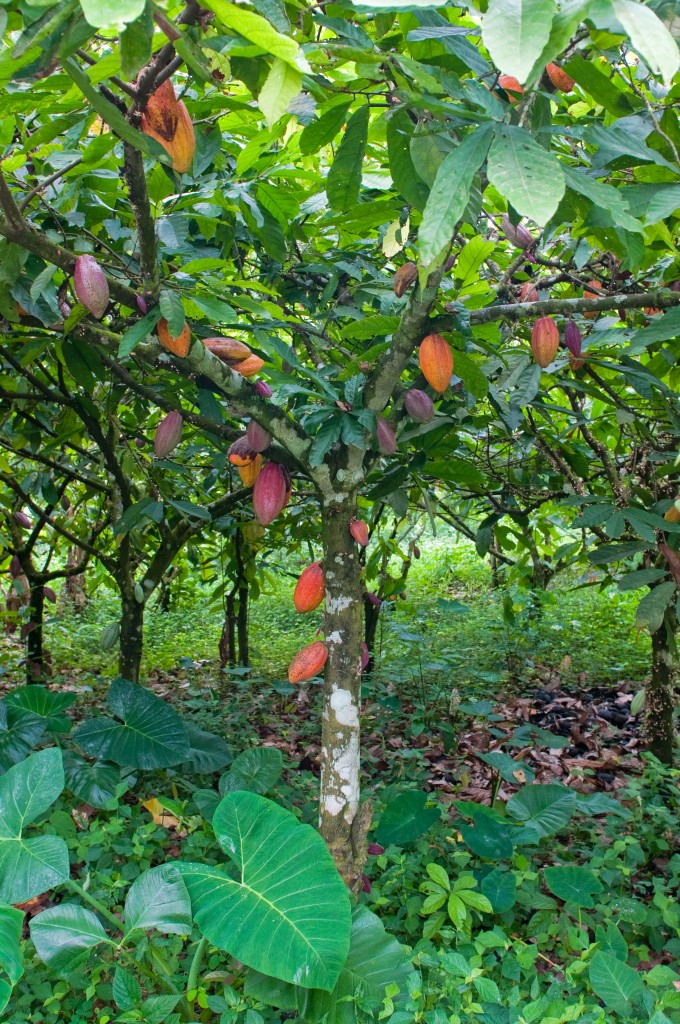As Valentine’s Day approaches, there is an annual rite of passage that does not change: searching for that perfect gift to make our significant other smile. And chances are many of us will end up giving or receiving the most classic of Valentine’s Day gifts: Chocolate. Americans spend more than a billion dollars on chocolate and candy for Valentine’s Day every year.
But what if, unbeknownst to us, our chocolaty gift of love came at the expense of some tropical forest half a world away? What if the cocoa used to make our chocolate may have contributed to tropical deforestation.
In fact, this is often the case. Cocoa is a main ingredient in chocolate, and much of the cocoa production around the world is associated with deforestation.
Cocoa Production Driving Deforestation
The majority of the world’s cocoa is grown in Africa, by small farmers on family-run farms. Financial returns to cocoa farmers are not very high, and many farmers lack access to fertilizers which would boost productivity on already-cleared land. As a result, cocoa farmers must at times resort to clearing fertile forest land in order to expand their productivity, boost their incomes, and provide for their families.
The West African country of Ghana is one case in point. Ghana is the second-largest cocoa producer in the world, after Côte d’Ivoire (Ivory Coast), and cocoa exports account for nearly a sixth of the country’s GDP. But Ghana estimates that it is losing 2% of its forests each year, with half of this loss directly related to agricultural expansion, particularly for cocoa production. Ghanaian government officials and non-governmental researchers, including Forest Trends and our partners, realized that this was unsustainable, and something needed to change. After all, forests provide an array of critical environmental services, including watershed protection—which directly benefits cocoa farmers—and carbon sequestration, which in the age of climate change benefits us all.
The Solution: Climate-Smart Cocoa
In recognition of this crisis, a coalition of government, environmental groups and industry launched a campaign to reverse this trend and grow “greener” chocolate. The Government of Ghana’s Forestry Commission, Cocoa Board, and environmental groups including Forest Trends and the Nature Conservation Research Center (NCRC), together with key private sector cocoa companies, worked together on a program that will provide farmers with access to critical farming resources, like extension and fertilizers, so they can boost their yields and incomes without having to expand their farms by clearing more forest.
This program, Climate Smart Cocoa, relatively simple in concept but relatively complex to put into place, is now being recognized as a critical way to conserve forests and mitigate climate change. Donor programs and private sector partners are taking note of the program’s logic and its cross-sector approach to finding solutions. With implementation planning and agreements being put in place, the Government is now finalizing a new strategy to integrate this initiative into a full-scale Emission Reductions Program for the “Cocoa Forest Mosaic Landscape”, under the World Bank Forest Carbon Partnership Facilities’ (FCPF) Carbon Fund.
Once implementation is underway and the program demonstrates that deforestation is being reduced, then the World Bank will provide Ghana with around $50 million as a reward or “performance-based payment” for conserving the forests and reducing carbon emissions from forest clearance for cocoa farms. In fact, two World Bank programs are set to provide funding in support of the Climate Smart Cocoa program: the FCPF’s Carbon Fund as well as the Forest Investment Program (FIP), which is supporting activities to help reduce deforestation in the cocoa landscape.
For more information on the funding to support Ghana’s forestry programs and their resulting emissions reductions, see the report released recently by Forest Trends, NCRC, and the Ghanaian Forestry Commission.
If the program is a success, everyone will emerge a winner. Cocoa farmers will produce more cocoa that has greater climate resilience and will boost their incomes without having to cut down forests; millions of tons of CO2 will remain stored in Ghana’s forests, lessening Ghana’s contribution to climate change and generating new sources of revenue in return; chocolate companies will benefit from the long term sustainability of a climate-smart cocoa bean, and all of us will be able to buy delicious Valentine’s Day chocolate with a clear conscience. Now that’s something to love.
The original version of this blog has been slightly modified to clarify that the Climate Smart Cocoa program in Ghana is still under development, with plans to begin implementation soon.
Viewpoints showcases expert analysis and commentary from the Forest Trends team.
Connect with us on Facebook and Twitter to follow our latest work.

